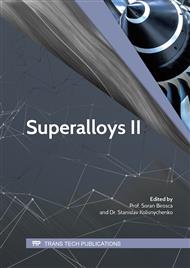p.741
p.747
p.753
p.759
p.766
p.772
p.778
p.784
p.790
Formation of Secondary Phases in the Boundary between Surface Defect Grains and Matrix in Third Generation Nickel-Based Single Crystal Superalloy Turbine Blades
Abstract:
Ni-based single crystal superalloy turbine blades have excellent mechanical strength and resistance to corrosion and oxidation due to a uniformly distributed gamma prime phase in a gamma matrix. However, defect grains have been often found on the surface of turbine blades after manufacturing, which can be potential sites of crack initiation. In this study, several different types of surface defect grains formed in third generation Ni-based single crystal turbine blades, such as stray grains, freckle chain grains, equiax grains, and a new grain formed in surface scale, had been investigated. The grain boundary regions were observed by high resolution electron microscopy. Although the formation mechanism of each grain defect is different, secondary phases, such as rhenium-rich particles, have been always found in each grain boundary. In addition, depending on the existence of the secondary phases as well as the size of defect grains, different microstructures were observed even in the same defect grain boundary. Finally, the observed results suggest that if there is any boundary region in a turbine blade, secondary phases, such as Re-rich particles, can be found.
Info:
Periodical:
Pages:
766-771
Citation:
Online since:
December 2018
Authors:
Keywords:
Price:
Сopyright:
© 2018 Trans Tech Publications Ltd. All Rights Reserved
Share:
Citation:



